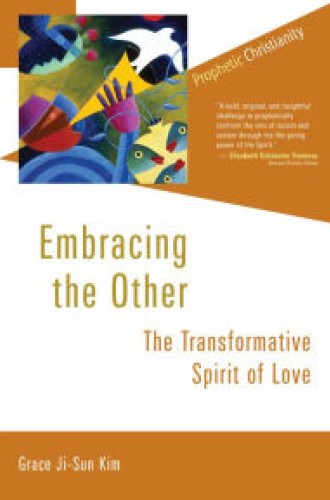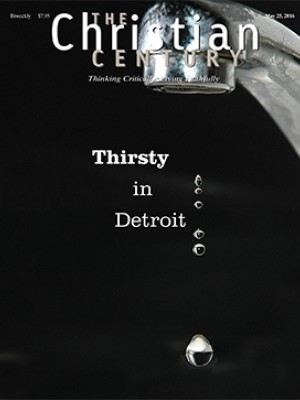Transformed by Spirit-Chi

Embracing the Other
Embracing the Other is the newest volume in the Prophetic Christianity series, in which “authors navigate difference and dialogue constructively about divisive and urgent issues of the early twenty-first century.” For Grace Ji-Sun Kim, the pressing issue is how we might move beyond racism and sexism and toward justice and reconciliation for everyone regardless of race or gender.
To address this issue, Kim brings together a number of strands: an examination of the “foreign women” of the Hebrew Bible; the history and experience of Asian immigrant women in North America as “foreign women”; insights from feminist, postcolonial, and Asian-American studies; and Kim’s own experiences as an Asian-American woman who teaches theology at Earlham School of Religion.
Read our latest issue or browse back issues.
Kim examines Ezra 9, where officials among the returned exiles report that some of their men have begun intermarrying with “foreign women” from the neighboring lands, contrary to God’s commands. Distressed by this news, Ezra tears at his hair and clothing, spends time in fasting and prayer, and then insists that such intermarrying must stop. What’s more, the foreign women end up paying the harshest penalty as the men in power decide that the women and their children are to be expelled from the community.
Just as these foreign women were marginalized and expelled from their adopted community, many Korean women who are immigrants to the United States struggle with marginalization and alienation. Kim is careful to acknowledge the diversity of women’s experiences and the diversity of those commonly grouped together as Asian American. At the same time, she ably addresses their common context, which includes the racialization of Asian Americans, the sense of hybridity between two cultures, the myth of the model minority, and the ongoing challenge of being identified as a perpetual foreigner.
Even as a third-generation Chinese Canadian, I can identify with the issues Kim raises. The myth of the model minority tells us that we will get ahead if we work hard, while masking the institutionalized racism faced by all minorities, including those of Asian descent. Although I was born and raised in Canada, as were my parents, I am seen as a perpetual foreigner. I have been asked many times: “No, where are you really from?” That might make for a humorous cross-cultural exchange as an isolated incident, but it also suggests much larger and more pressing questions. How do we relate to those we see as foreigners? How do we free ourselves of stereotypes and marginalization of the other in favor of welcoming their unique perspectives and gifts? How might we embrace the other and work toward healing, justice, and reconciliation?
As a way forward, Kim turns to the Holy Spirit, who animated the early church as a shalom justice community of reconciliation. Building on her earlier work The Holy Spirit, Chi, and the Other, Kim expresses this Spirit God as Spirit-Chi, bringing together the Chinese word for life-giving energy force and the biblical concepts of the Spirit and shalom justice.
Her approach spans the globe and various religious traditions as she reviews understandings from Hegel and Nietzsche, Native American stories, the breath of God in the Qur’an, the num among the Kung San people of the Kalahari Desert, Indian prana, Japanese Ki, and Hawaiian ha. These are little more than brief sketches, but they demonstrate both our limited understanding and our need for a larger vision of the Spirit, who is present in all places and among all people.
For Kim, it is the loving, life-giving, transformative power of the Spirit—what she calls the Divine Eros—that connects us, moves within us, and can heal the wounds of our division. Our openness to the Spirit can make us more aware of our common humanity, while the Spirit empowers us to move beyond stereotypes and marginalization to welcome and embrace the other.
This vision is compelling, but I wish some of Kim’s ideas were more fully developed. Why does she say in her introduction that focusing on Jesus has limited how we are to love one another? Why does she refer to the Divine Eros rather than the Divine Agape? How are those two forms of love related and different? I suspect that her choice reflects her emphasis on the Spirit as living, moving, and passionate, but she doesn’t address this directly. More important, how does the transformative, erotic love of Spirit-Chi translate into concrete practices of healing, justice, and reconciliation? She lays out the challenge to embrace the other, and she notes the need to be open to the Spirit, to make the necessary commitment, to invest our time and effort in patient and persistent love. All this leaves me wanting more.
Perhaps that’s the way of theology—to lay the groundwork and leave the working out to our lived reality. And perhaps these questions are dealt with more thoroughly in some of Kim’s other writings: in addition to her numerous articles, I count eight books in five years that she has written or edited alone or in collaboration with others, with The Homebrewed Christianity Guide to the Holy Spirit still to come this year. I look forward to reading more from this prolific and creative theologian.





